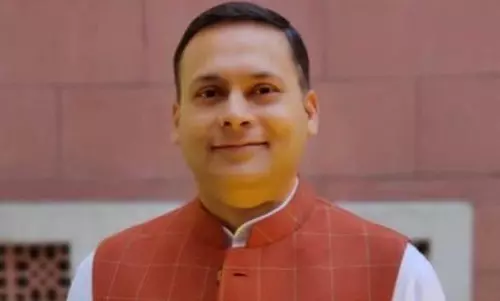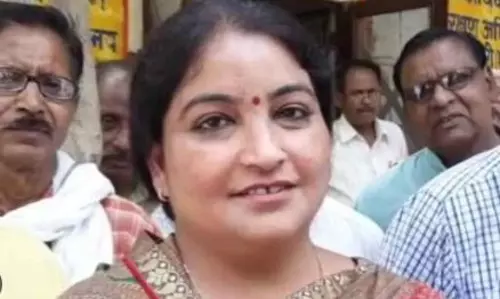
India's growth slumps to over 6-yr low of 5 pc in June qtr; below China's
text_fieldsNew Delhi: India's economic growth on Friday slumped for the fifth straight quarter to an over six-year low of 5 per cent in the three months ended June as consumer demand and private investment slowed amid deteriorating global environment.
Having lost the tag of the world's fastest-growing economy earlier this year, India's GDP growth was behind China's 6.2 per cent in April-June, its weakest pace in at least 27 years.
The Gross Domestic Product (GDP) of India, Asia's third-largest economy, slumped by larger than expected 5 per cent in April-June, the slowest pace since January-March 2013.
The growth stood at 5.8 per cent in January-March of 2019 and 8 pe cent of April-June 2018, according to official data released on Friday.
Government's Chief Economic Adviser K V Subramanian said India's GDP numbers indicate that growth while still high, has shown some slowdown.
"Similar phenomenon has been observed previously in the last quarter of 2013-14," he said.
"This has been on account of both exogenous and endogenous factors. The government is quite alive to the situation especially global headwinds arising out of deceleration in the developed economic and Sino-American trade conflict which has contributed to the slowdown," he noted.
Prior to announcement of GDP numbers, the government on Friday announced its second of the three-part stimulus, merging 10 public sector banks into four with a view to boost credit to help revive the economy.
Last week, the first stimulus package was announced that included reduction of taxes, improvement of liquidity in the banking sector (formal and shadow), increased government spending on auto and infrastructure, and accelerated refunds of Goods and Services Tax (GST).
This was followed by liberalisation of foreign investment rules in four sectors -- coal mining, contract manufacturing, single-brand retail and digital media.
A third and possibly last package, expected in the next few days, may deal with issues facing the realty sector.
The Chief Economic Adviser said the government has been taking all necessary steps in short term and medium term to take care of the situation.
"The investment rate actually seems to be picking up. The capacity utilisation is increasing now and is now comfortably above 76 per cent," he said. "What is critical for that 8 per cent growth is investment", he added.
The Budget for 2019-20, he said, has announced Rs 100 lakh crore investment in infrastructure creation in the next five years which has the ability to crowd in investment.
"Given some of the green shoots I have spoken on the investment side, we should be assured that higher growth would start manifesting in some time. Right now, we are sticking to the forecast of achieving 7 per cent growth in FY20 (April 2019 to March 2020)," Subramanian said.
Declining savings especially household saving is a major challenge for the economy and is leading to structural growth slowdown, Fitch Group's India Ratings and Research chief economist Devendra Pant said.
"While the fiscal space to undertake counter-cyclical measures are very limited, we believe, the government would undertake some measures to provide a short-term boost to the economy," he said.
After agriculture, real estate/ construction is the second-largest employer and also has a huge backward and forward linkages with other sectors. So reviving real estate sector would be crucial both from the investment as well as consumption point of view, he noted.
The rating agency believed that there is no quick-fix solution to the downturn which has been in the making for the past few years. "Hence, the recovery will also take its own time," he said, adding the RBI may cut interest rates one more time to boost demand.
So far, RBI has cut interest rate by 110 basis points this year.
"The growth slowdown was led by private final consumption expenditure, which grew 3.1 per cent only (18 quarter low). Investment demand also remained lackluster and fixed capital formation grew 4.0 per cent (4QFY19: 3.6 per cent). Only government expenditure provided support to growth and increased by 8.8 per cent," he said.
While general elections in April-May 2019 had some impact on investment growth, the collapse of private consumption demand from 10.6 per cent in 4QFY18 to 3.1 per cent in 1QFY20 is the real cause of concerns, he said.
"Ind-Ra believes both structural and cyclical issues are plaguing Indian economy and in order to bring the economy back to a respectable growth path both short-term and long term measures are required," he noted.
The Gross Value Added (GVA) growth in the manufacturing sector tumbled to 0.6 per cent in the first quarter of this fiscal from 12.1 per cent expansion a year ago.
Similarly, farm sector GVA growth remained subdued at 2 per cent as compared to 5.1 per cent in the corresponding period of the previous fiscal.
Construction sector GVA growth too slowed to 5.7 per cent from 9.6 per cent earlier.
However, mining sector growth climbed to 2.7 per cent from 0.4 per cent a year ago.
The previous low in GDP growth was recorded at 4.3 per cent in the January-March quarter of 2012-13. India's economic growth stood at 8 per cent in the same quarter of 2018-19.
The Reserve Bank had marginally lowered the GDP growth projection for 2019-20 to 6.9 per cent from 7 per cent projected earlier in the June policy and underlined the need for addressing growth concerns by boosting aggregate demand.























